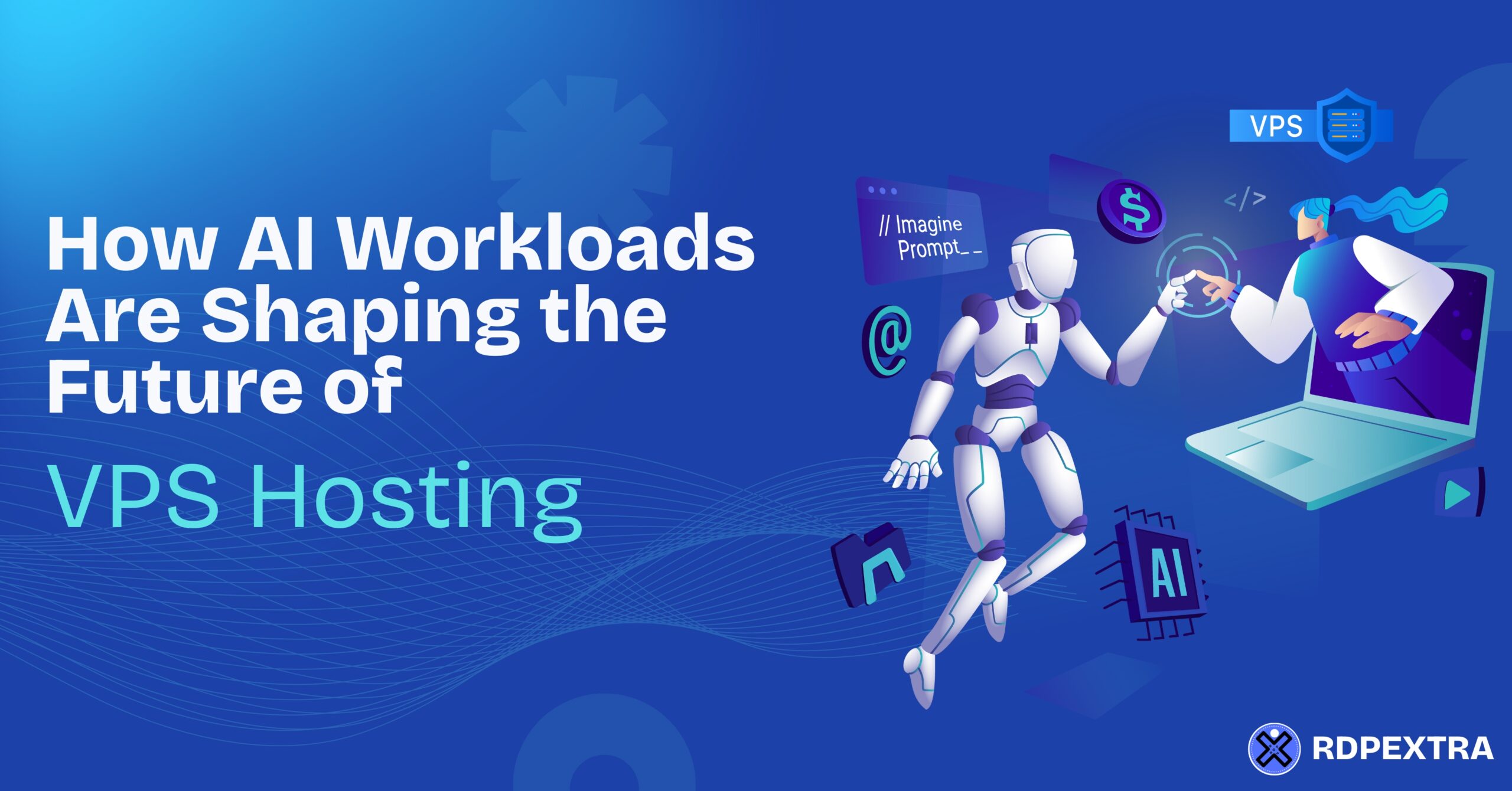
VPS for AI Workloads — GPUs, Linux & How to Choose
Introduction — The AI hosting problem, simplified
AI went from curiosity to core business function in a few short years. AI workloads in VPS hosting Suddenly, you’re not just hosting a website — you’re training models, deploying inference endpoints, and moving terabytes of data between storage and compute. Those changes that make sense.
Public cloud GPU instances are powerful, but they can also be expensive and unpredictable at scale. Enter a pragmatic middle ground: modern VPS hosting for AI — increasingly Linux VPS hosting with optional VPS with GPU support — that blends cost, control, and developer-friendliness. Early signs show teams are increasingly evaluating VPS hosting for AI and even dedicated infrastructure for AI workloads as cost, control, and compliance become decisive factors.
Why AI workloads are different (and why that matters for hosting)
AI workloads impose unusual demands compared with typical web apps:
- Training vs inference: Training is compute- and GPU-heavy (long, bursty runs). Inference often requires low-latency responses at scale (many small requests). The two have different hosting needs.
- GPU, memory, and I/O hunger: GPUs accelerate matrix math, but they also need fast NVMe storage for datasets and lots of RAM to avoid CPU bottlenecks.
- Data movement & networking: When datasets are large, transfer speeds and data locality quickly AI workloads in VPS hosting become bottlenecks (and cost drivers).
- Software stack complexity: You need OS-level drivers (NVIDIA), CUDA/cuDNN, container runtimes, and specific Python packages — which favors environments where you control the OS (i.e., VPS/Linux).
Recognizing these differences is step one; choosing infrastructure follows from which of these constraints dominate your workload.
Why VPS hosting for AI is gaining momentum
Here’s why many teams are seriously considering VPS for AI workloads:
- Predictable pricing & lower overhead for small-to-medium scale — For iterative model development and light-to-moderate training, many VPS providers now offer GPU-backed options at prices that compete with big-cloud short runs. This makes VPS for AI workloads attractive for startups and indie developers.
- Control & customizability — With root access to a Linux VPS, you can install drivers, tune kernels, and use containers the way you want. For regulated workloads, physical/dedicated control matters more than cloud-managed convenience.
- Specialized, GPU-ready offerings — In 2024–25 a growing AI workloads in VPS hosting number of VPS providers list GPU or GPU-dedicated plans (NVIDIA RTX/A100/H100 families) making AI-capable VPS realistic.
- Linux as the default environment — Most AI frameworks and driver ecosystems (CUDA) are Linux-first, making Linux VPS hosting the natural fit.
Bottom line: for many projects, the right VPS (especially Linux VPS hosting with GPU optionality) gives the best trade-offs between cost, control, and developer ergonomics.
Linux VPS hosting — the default for AI
If you’re serious about AI on VPS, choose Linux:
- Driver & tooling compatibility — NVIDIA drivers, CUDA, Docker + NVIDIA Container Toolkit, and ML frameworks are most stable on Linux. Common distros: Ubuntu LTS, Debian, and Rocky/Alma for enterprise contexts.
- Ecosystem & automation — CI, Ansible, Terraform, and container images are all Linux-native. That reduces friction when deploying models or reproducible experiments.
- Security & minimal surface area — Lean Linux images reduce attack surface; you can further harden kernel settings and container policies.
Pro tip: build a base image with drivers and Docker/NVIDIA runtime installed, snapshot it, and reuse it for faster spinups.
What “VPS with GPU support” actually means
Not all GPU VPS plans are the same. VPS with GPU support Expect variations:
- Shared GPU (virtualized GPUs) — GPU time is multiplexed across tenants; cheaper but noisy for heavy training.
- Dedicated GPU (vGPU or full passthrough) — You get exclusive or ultra-reliable GPU access; best for heavy training or latency-sensitive inference.
- PCIe passthrough / bare-metal GPU nodes — Most predictable performance; near-dedicated hardware.
- Multi-GPU & networked GPUs — For distributed training, you may need multi-GPU nodes or cluster networking (RDMA) support.
Common cards offered across vendors range from consumer RTX series (good for prototyping) to data-center A100/H100-class cards for production training. Make sure the provider documents the exact GPU model and driver compatibility.
How to choose a VPS for AI workloads — step-by-step checklist (with reasoning)
Use this decision flow to pick a plan quickly.
1 — quantify your workload
- Training? How many GPU-hours per week?
- Inference? What are QPS (queries per second) and latency targets?
Why this matters: training favors large dedicated GPUs and high I/O; inference favors many small instances, autoscaling, and lower-latency networking.
2 — pick GPU vs CPU
- If >50% of compute is matrix ops → choose GPU.
- If serving light models (tiny transformers) → CPU inference might be cheaper.
3 — size memory & storage
- Large datasets → NVMe local storage or high-throughput block storage is essential.
- For repeated training runs, local NVMe beats network storage for speed.
4 — networking & data costs
- If you’re moving TBs across regions, egress costs matter. Co-locate storage and compute where possible.
5 — software compatibility & OS
- Confirm the provider allows custom images/root access and supports Docker + NVIDIA runtime on Linux.
6 — support & SLAs
- For production inference, SLAs and quick hardware replacement are crucial.
Example scenarios
- Prototype model training: single RTX 4090-like GPU VPS with 64GB RAM, NVMe — good balance.
- Production inference fleet: many smaller instances or containerized endpoints with autoscaling.
- Large-scale training: consider dedicated multi-GPU nodes or hybrid with cloud HPC instances.
(These steps are practical reasoning — do the quantification first, then match to hardware; it avoids overpaying for unused GPU hours.)
Where to look — providers & what to expect in 2025
The market has matured: many VPS providers now list GPU or GPU-adjacent plans. You’ll find:
- Specialized GPU VPS shops and marketplaces offering a range of cards from consumer RTX to A100/H100 for heavy workloads.
- Traditional VPS providers are adding GPU tiers — expect on-demand and reserved options from established VPS hosting for AI.
- Cloud & hybrid options — some teams combine VPS/GPU nodes for prototyping and cloud GPUs for large-scale training runs.
When researching vendors, watch for clear documentation on GPU models, driver support, networking performance, and real user reviews.
Architecture patterns — when to use VPS vs cloud GPUs vs dedicated servers
- VPS (single/multi GPU) — Best for prototyping, small training runs, and predictable inference at modest scale. Good balance of cost and control.
- Cloud GPU instances (AWS/GCP/Azure) — Best when you need massive scale briefly or tight integration with cloud services. Higher cost, better autoscaling & managed tooling.
- Dedicated servers / on-prem — Best for sustained, heavy training workloads where data sensitivity, latency, or predictable long-term cost is primary. Dedicated servers are seeing renewed interest due to AI demands.
Hybrid setups are common: local VPS for AI workloads + cloud for big training jobs.
Cost & optimization tips
- Use mixed precision and optimized libraries — reduces GPU memory needs and speeds up training.
- Batch and pipeline efficiently — larger effective batch sizes reduce overhead.
- Use spot/preemptible instances for non-urgent training — cheaper but ephemeral.
- Cache datasets & use local NVMe — avoid repeated network transfers.
- Right-size early — too-large instances waste money; measure and iterate.
Security, compliance & operations
- Isolation — for multi-tenant VPS, ensure tenant isolation and consider dedicated nodes for sensitive data.
- Backups & snapshots — automate backups of models and training checkpoints.
- Monitoring & observability — GPU utilization, memory pressure, and I/O latency should be tracked.
- Compliance — if data is regulated, prefer providers with relevant certifications or use dedicated hardware.
The near-term future — what to watch
Expect three trends to shape VPS hosting for AI:
- More GPU-ready VPS plans as GPUs become a commodity and vendor competition increases.
- Stronger Linux-focused tooling and prebuilt images optimized for ML on VPS hosting for AI.
- A mixed market where dedicated, VPS, and cloud co-exist—teams will choose based on cost predictability, performance, and compliance. Industry surveys show an uptick in companies moving some workloads back to dedicated or private infrastructure because of AI demands.
Conclusion — pick the right tools, not the flashiest ad
AI workloads changed the rules: the right hosting choice is now a function of model type, dataset size, latency needs, and budget. Linux VPS hosting, especially VPS with GPU support, offers a compelling middle ground — giving developers control and predictable costs while supporting the core tech stack AI teams rely on. If you follow the checklist above (quantify → pick GPU → size storage & network → verify software), you’ll save money and iteration time.
Want a ready-made checklist? Invite readers to download our checklist to choose the perfect VPS for AI workloads — from prototyping to production. (CTA: Download the AI & VPS Decision Checklist.

Leave a Reply